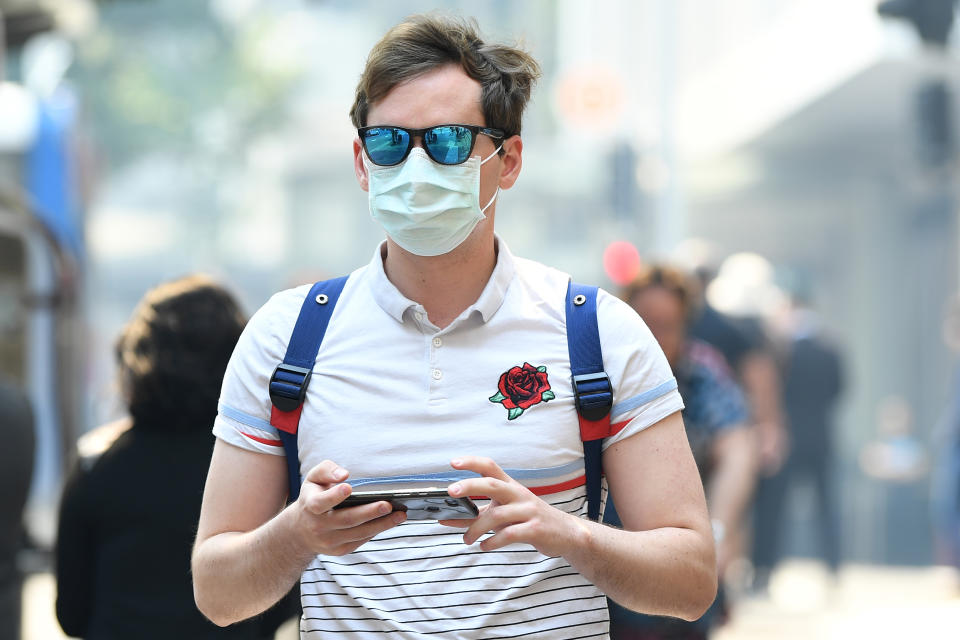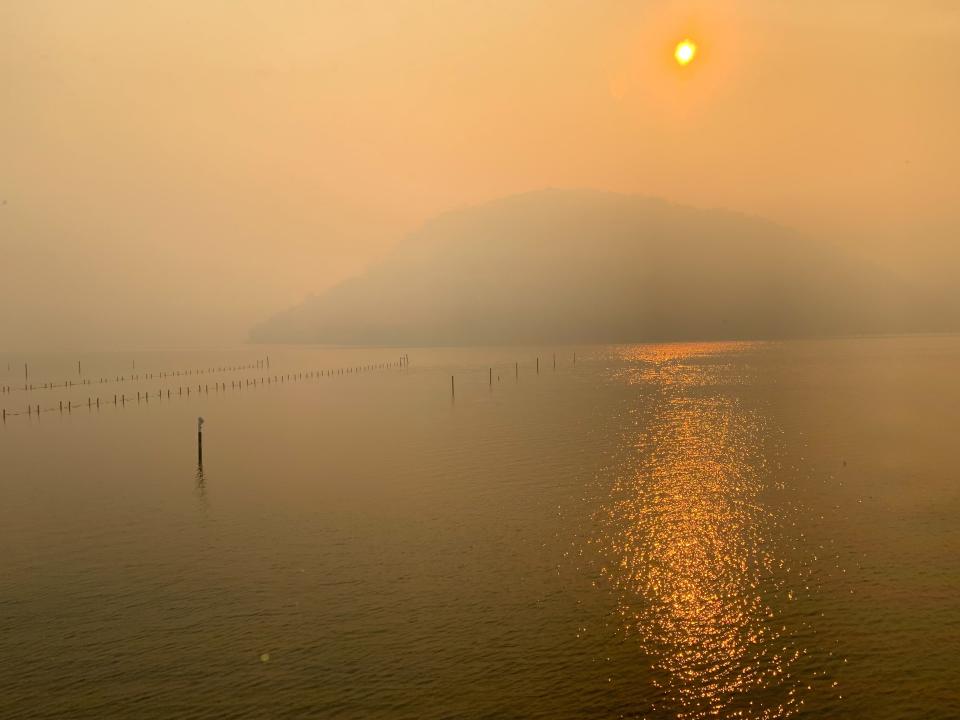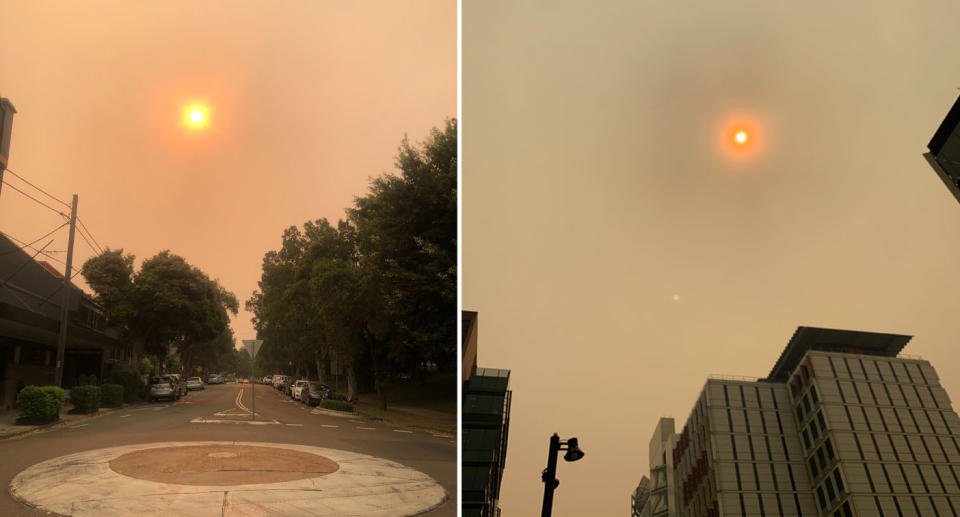The heart attack risk associated with the Sydney smoke epidemic
The air pollution epidemic in Sydney and across NSW is the longest and most widespread on record, the Department of Planning, Industry and Environment announced this week.
Once again on Thursday morning, parts of Sydney's east, southwest and northwest were rated as "hazardous" for air pollution with a layer of thick smoke once again blanketing the city – an alarming sight that has become the norm in recent weeks.
The situation was worsening in the afternoon with seven fires at emergency level.
“The impacts of the ongoing drought and recent bushfires have led to some of the highest levels of air pollutants recorded in NSW since air quality monitoring began during the millennium drought,” a department spokesperson told Yahoo News Australia.

Sydney has ranked in the top 10 of cities across the world with the worst air-pollution on several occasions in the last fortnight, according to air quality website AirVisual. On Thursday, Sydney ranked 18th – higher than cities notorious with air pollution such as Beijing, Guangzhou and Mumbai.
The department’s data reveals Sydney's air quality for the current bushfire season is more than three times worse than any period over the last five years.
Do I need a mask for the smoke?
Wearing masks during periods of pollution is a common trend across Asia, particularly China, and the practice has slowly begun to emerge across Sydney.
However Queensland University of Technology’s Dr Tom Cole-Hunter, a postdoctoral researcher at the Centre for Air pollution, energy and health Research, told Yahoo News Australia that the majority of masks worn to combat air pollution were ineffective.

“These cloth or surgeon masks are not effective, they’re only effective against disease or infections spread through aerosols and water droplets.”
He said there was one type of facial covering – the P2 mask – which is effective in blocking the smoke particles found in bushfire smoke, however, experts have warned even then, many aren’t being applied correctly.
Smoke brings heart attack risk
Dr Cole-Hunter said the biggest worry with particles from the bush fires was their microscopic size.
“The main concern when you get particles small enough, they can get past all the natural defences of the upper airways,” he said.
“These particles can be carried into and through the blood circulation of the body if tiny enough and there’s some evidence they can even affect the nervous and reproductive system.”
This in turn can trigger an inflammatory response in the body’s tissue, causing swelling which could lead to health issues such as elevated blood pressure, Dr Cole-Hunter said.
This could trigger other health problems such as heart attacks.
He noted that with the current air pollution only predicted to last several weeks, the average Australian shouldn’t be too concerned for their health, particularly as the human body over the millenia has evolved those natural defences against exposure to an array of similar pollutants in the air such as camp fires.
Head of Research at the Climate Council Dr Martin Rice told Yahoo News Australia earlier this week that experiencing the hazardous levels in Sydney was the same as smoking 40 cigarettes a day – an analogy widely spread this week.

However, Dr Cole-Hunter said the smoke in bushfires differed from that of cigarettes.
“The thing is with cigarettes there’s a cocktail of chemical compounds inside,” he said.
Dr Cole-Hunter said it would take “months and months of exposure” for the smoke to start having a long-term health effect on the body.
“If I was to smoke a pack of cigarettes for a week, I would have a response to the body but it would eventually recover over time once I stop smoking,” he explained.
Those who need to tread with caution are people with underlying conditions – such as asthma – that might be triggered by the smoke, Dr Cole-Hunter said.
Elderly people, children and pregnant women should also try to avoid smoke inhalation the most.
Dr Cole-Hunter said recent research suggested that a prolonged period of smoke inhalation from fires had an effect on the development of people, even unborn children.
He also noted prolonged exposure to smoke could irritate the naked eye.
‘Apocalyptic’ scenes - how long it will it last?
However the Bureau of Meteorology’s weather predictions for the summer indicate “a more severe fire season for southeast Australia” due to a positive Indian Ocean Dipole (IOD).
This means the bushfires and haze could continue to affect Sydney, sending its residents into uncharted territory, and ultimately begin to affect healthy individuals.
The IOD is the difference in temperatures between the eastern and western sides of the Indian Ocean and has remained positive since May.
A positive IOD means southern and central parts of Australia receives significantly less rainfall and increased temperatures for the southern areas of the country – conditions which have contributed to the ongoing bushfire crisis NSW and Queensland are currently going through.

According to BoM’s latest observations, the positive IOD is so strong, the dry and hot conditions could last well into summer.
Weatherzone meteorologist Kim Westcott told Yahoo News Australia as long as the fires continue to burn in Sydney’s vicinity, smoke will continue to blanket the city.
“For most of Sydney northwesterly winds and fires burning to the west and northwest has brought the smoke over,” she said.
The Bureau of Meteorology confirmed heavy smoke billowing from the bushfires surrounding Sydney will linger in the city basin until Saturday.
Heavy smoke has been blowing into the city from a large fire near Warragamba Dam near the Blue Mountains, the RFS says, as well as additional fires in the Hawkesbury and Wollondilly regions.
Conditions are deteriorating at a number of bush fires burning around the Sydney, Hawkesbury and Central Coast areas. Smoke is clearly visible on @BOM_NSW radar. It will be very smoky around these areas this afternoon. #nswrfs #nswfires pic.twitter.com/kSlTKeS9wj
— NSW RFS (@NSWRFS) December 5, 2019
Love doing laps in the Sydney sun! What we see here is completely normal! Doesn’t at all resemble the palette of a dread-inducing hellscape! pic.twitter.com/AOIGgUJeDk
— Benjamin Law 羅旭能 (@mrbenjaminlaw) December 4, 2019
"An overnight temperature inversion will trap the smoke in the Sydney basin. This means smoke will settle in many areas and be very heavy," the RFS said in a statement.
Such conditions have been described as “apocalyptic” on social media by Sydneysiders, with hundreds sharing photos online.
Many images feature a deep red sun, which is caused by the high quantity of particulates in the air as well as dust from the west, Ms Westcott said.
According to the NSW Rural Fire Service, 112 fires were still burning on Thursday afternoon with 56 out of control.
Do you have a story tip? Email: newsroomau@yahoonews.com.
You can also follow us on Facebook, Instagram and Twitter and download the Yahoo News app from the App Store or Google Play.




